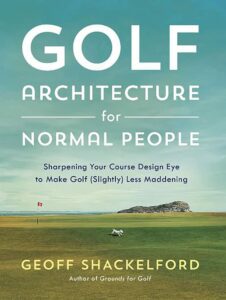Golf Architecture for Normal People: Sharpening Your Course Design Eye to Make Golf (Slightly) Less Maddening
June 15, 2023
Life is full of coincidences, especially if you are open to the possibility that some of them are planned that way.
I thought of this while reading Geoff Shackelford’s fun new book, “Golf Architecture for Normal People,” available through Bookshop.org and Amazon.com ($30.00 SRP).
Shackelford often appears on The Golf Channel and has a popular website, geoffshackelford.com. He is especially well known and appreciated among fans of golf course design and the architects who create these living works of the sporting arts.
The former Pepperdine University golfer has covered the subject comprehensively for over twenty-five years, with several books to his credit as either primary author or editor. I reviewed and recommended several of them at HoleByHole.com, including The Art of Golf Design, Alister MacKenzie’s Cypress Point Club, The Golden Age of Golf Design, Lines of Charm, and Masters of the Links.
His depth of knowledge in this specialized field (pardon the pun) did not go unnoticed. Shackelford worked with Hanse Golf Design in the creation of Rustic Canyon Golf Course, an award-winning layout in Moorpark, CA.
Another of his books, a biography of legendary architect George Thomas, was certainly instrumental in Shackelford’s more recent contributions during the restoration and renovation of Los Angeles Country Club.
Thomas did a major redesign of LACC in the 1920s which many consider among his best work.
LACC also happens to be the host of the 2023 United States Open.
This is what I mean by a potentially planned coincidence – not that there’s anything wrong with that.
As in his prior publications, in his newest book Shackelford shows a deep appreciation for what can be done to create a golf course that appeals to the broadest possible golfing audience. However, he is not such a fanboy that he won’t discuss why some designs fail to deliver.
Like most other outdoor sports, golf requires an artificial playing area in which to compete. Unlike most other outdoor sports, the best golf course designs create landforms and features that give the impression they were in place well before anyone thought to put a tee down and see what happened.
Shackelford argues for a few elements he contends are best suited to meet that goal. These include the easy ability to remember each hole’s features, challenges, and rewards; enough playing versatility to keep coming back; and a pleasant, walkable environment, suitable for golfing while accompanied by a faithful doggie companion.
That last element runs afoul of most courses I have played, but I understand his point. Even for those layouts that prohibit dogs, they should nonetheless inspire the idea that a dog would probably love to check out the place and have a great time.
And if a dog likes it, why wouldn’t most humans?
Shackelford’s prose is succinct, often witty, and accessible. “Golf Architecture for Normal People” could even inspire interested readers to check out his other books about golf design – after first watching the U.S. Open at LACC, of course.
That might also be a coincidence – but it would be a happy one for them, and him.


